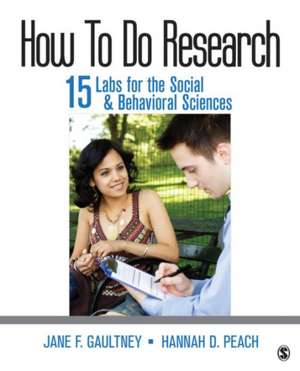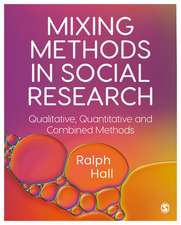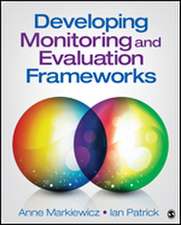How To Do Research: 15 Labs for the Social & Behavioral Sciences
Autor Jane F. Gaultney, Hannah D. (duBreuil) Peachen Limba Engleză Paperback – 8 mar 2016
Preț: 393.55 lei
Preț vechi: 504.56 lei
-22% Nou
Puncte Express: 590
Preț estimativ în valută:
75.31€ • 78.18$ • 62.80£
75.31€ • 78.18$ • 62.80£
Carte disponibilă
Livrare economică 04-18 martie
Livrare express 15-21 februarie pentru 31.19 lei
Preluare comenzi: 021 569.72.76
Specificații
ISBN-13: 9781483385129
ISBN-10: 1483385124
Pagini: 304
Dimensiuni: 187 x 232 x 25 mm
Greutate: 0.5 kg
Ediția:1
Editura: SAGE Publications
Colecția Sage Publications, Inc
Locul publicării:Thousand Oaks, United States
ISBN-10: 1483385124
Pagini: 304
Dimensiuni: 187 x 232 x 25 mm
Greutate: 0.5 kg
Ediția:1
Editura: SAGE Publications
Colecția Sage Publications, Inc
Locul publicării:Thousand Oaks, United States
Cuprins
PART I: Before You Collect Data
LAB 1. Finding a Topic, Finding Sources, and Critically Reading Appropriate Articles
Finding a Topic
What Are the Steps of a Research Project?
Tips for Finding Sources
How to Read an Article
Closure
If You Want to Go Further . . . Secondary Analyses of Large Data Sets Available Online
LAB 2: How to Write a Literature Review
The Literature Review
APA Style
If You Want to Go Further . . . Writing “Good”
LAB 3: After the Literature Review: Theory > Hypothesis > Design > Analysis > Results > Interpretation
The Logic Behind the Research
Theory > Hypothesis > Design > Analysis: Method Section
Theory > Hypothesis > Design > Analysis > Results
Theory > Hypothesis > Design > Analysis > Results > Interpretation
If You Want to Go Further . . . Cultural Considerations
Pick a Card, Any Card . . .
LAB 4: Ethics of Research
How to Treat Participants (Human or Otherwise)
The Ethics of Reporting Research
If You Want to Go Further . . . The Role of the IRB
Preparing a Proposal for the IRB
What to Expect Once Your Project Has Been Approved
PART II: Collecting Data - Research Designs and Tools
LAB 5: Qualitative Research
Qualitative Research: What Is It, and What Do You Do With It?
If You Want to Go Further . . . Content Analysis
What’s the Point of All This Qualitative Information? Development of a Grounded Theory
Communicating the Results
LAB 6: Case Studies and Single-Subject Designs
Case Study Versus Single-Subject Design
Who Uses Behavior Modification?
If You Want to Collect Your Own Data . . . It's All About You
If You Want To Go Further . . . Large-Scale Epidemiology: The Opposite Approach
LAB 7: Surveys
Types of Survey Questions
Writing the Method
If You Want To Collect Your Own Data . . .
Distributing the Survey
Informed Consent—Really, Really Important!
Producing the Abbreviated Lab Report
If You Want to Go Further . . . Developing the Survey
LAB 8: Descriptive and Inferential Statistics
Descriptive Versus Inferential Statistics
Scales of Measurement
T-Test
Closure
If You Want to Go Further . . . More About Effect Size
Types of Effect Size Statistics
How Big Is Big Enough?
To Summarize
Reviewing What You've Learned: Answer Key
LAB 9: Correlational Design
Experimental Versus Non-Experimental
If You Want to Collect Your Own Data . . . Closure
If You Want to Go Further . . . Partial Correlations
LAB 10: Regression Analysis
A Step Up
Practice and Review
Summing Up
If You Want to Go Further . . . Hierarchical Regression
LAB 11: Two-Group Designs
The Two-Group Design
If You Want to Collect Your Own Data . . . Be the Participant
Levels of Processing Data
If You Want to Go Further . . . Chi-Squared Analysis
LAB 12: Multiple-Groups Designs
Going Beyond the Two-Group Design
If You Want to Collect Your Own Data . . . Cautions!
Putting It All Together
If You Want to Go Further . . . Categorical IVs and DVs in Regression
Coding Categorical Predictor Variables for Regression
Logistic Regression
LAB 13: Factorial Designs
Background
Are We There Yet?
More Practice With Interactions
If You Want to Go Further . . . More About Testing Interactions
What Happens With Categorical Predictors?
What Happens With Repeated-Measures Data?
Answers for More Practice With Interactions
PART III: After Collecting Data
LAB 14: Writing the Discussion Section, Sharing Your Findings Using a Poster or Oral Presentation
Discussion Section Checklist
Creating and Presenting a Poster
Preparing an Oral Presentation of Your Findings
Closure
If You Want to Go Further . . . The Publication Process: What to Expect When You’re Submitting
LAB 15: Tables and Figures
Tables
Figures
How Do I Create a Figure?
Using SPSS
If You Want to Collect Your Own Data . . .
If You Want to Go Further . . .
A Few More (Optional) Things
In Conclusion
LAB 1. Finding a Topic, Finding Sources, and Critically Reading Appropriate Articles
Finding a Topic
What Are the Steps of a Research Project?
Tips for Finding Sources
How to Read an Article
Closure
If You Want to Go Further . . . Secondary Analyses of Large Data Sets Available Online
LAB 2: How to Write a Literature Review
The Literature Review
APA Style
If You Want to Go Further . . . Writing “Good”
LAB 3: After the Literature Review: Theory > Hypothesis > Design > Analysis > Results > Interpretation
The Logic Behind the Research
Theory > Hypothesis > Design > Analysis: Method Section
Theory > Hypothesis > Design > Analysis > Results
Theory > Hypothesis > Design > Analysis > Results > Interpretation
If You Want to Go Further . . . Cultural Considerations
Pick a Card, Any Card . . .
LAB 4: Ethics of Research
How to Treat Participants (Human or Otherwise)
The Ethics of Reporting Research
If You Want to Go Further . . . The Role of the IRB
Preparing a Proposal for the IRB
What to Expect Once Your Project Has Been Approved
PART II: Collecting Data - Research Designs and Tools
LAB 5: Qualitative Research
Qualitative Research: What Is It, and What Do You Do With It?
If You Want to Go Further . . . Content Analysis
What’s the Point of All This Qualitative Information? Development of a Grounded Theory
Communicating the Results
LAB 6: Case Studies and Single-Subject Designs
Case Study Versus Single-Subject Design
Who Uses Behavior Modification?
If You Want to Collect Your Own Data . . . It's All About You
If You Want To Go Further . . . Large-Scale Epidemiology: The Opposite Approach
LAB 7: Surveys
Types of Survey Questions
Writing the Method
If You Want To Collect Your Own Data . . .
Distributing the Survey
Informed Consent—Really, Really Important!
Producing the Abbreviated Lab Report
If You Want to Go Further . . . Developing the Survey
LAB 8: Descriptive and Inferential Statistics
Descriptive Versus Inferential Statistics
Scales of Measurement
T-Test
Closure
If You Want to Go Further . . . More About Effect Size
Types of Effect Size Statistics
How Big Is Big Enough?
To Summarize
Reviewing What You've Learned: Answer Key
LAB 9: Correlational Design
Experimental Versus Non-Experimental
If You Want to Collect Your Own Data . . . Closure
If You Want to Go Further . . . Partial Correlations
LAB 10: Regression Analysis
A Step Up
Practice and Review
Summing Up
If You Want to Go Further . . . Hierarchical Regression
LAB 11: Two-Group Designs
The Two-Group Design
If You Want to Collect Your Own Data . . . Be the Participant
Levels of Processing Data
If You Want to Go Further . . . Chi-Squared Analysis
LAB 12: Multiple-Groups Designs
Going Beyond the Two-Group Design
If You Want to Collect Your Own Data . . . Cautions!
Putting It All Together
If You Want to Go Further . . . Categorical IVs and DVs in Regression
Coding Categorical Predictor Variables for Regression
Logistic Regression
LAB 13: Factorial Designs
Background
Are We There Yet?
More Practice With Interactions
If You Want to Go Further . . . More About Testing Interactions
What Happens With Categorical Predictors?
What Happens With Repeated-Measures Data?
Answers for More Practice With Interactions
PART III: After Collecting Data
LAB 14: Writing the Discussion Section, Sharing Your Findings Using a Poster or Oral Presentation
Discussion Section Checklist
Creating and Presenting a Poster
Preparing an Oral Presentation of Your Findings
Closure
If You Want to Go Further . . . The Publication Process: What to Expect When You’re Submitting
LAB 15: Tables and Figures
Tables
Figures
How Do I Create a Figure?
Using SPSS
If You Want to Collect Your Own Data . . .
If You Want to Go Further . . .
A Few More (Optional) Things
In Conclusion
Notă biografică
Descriere
With step-by-step instructions covering the entire research process, and with an emphasis on meaningful analysis to encourage good judgement, this book provides that ideal stepping stone between learning about research and actually doing it


















